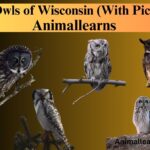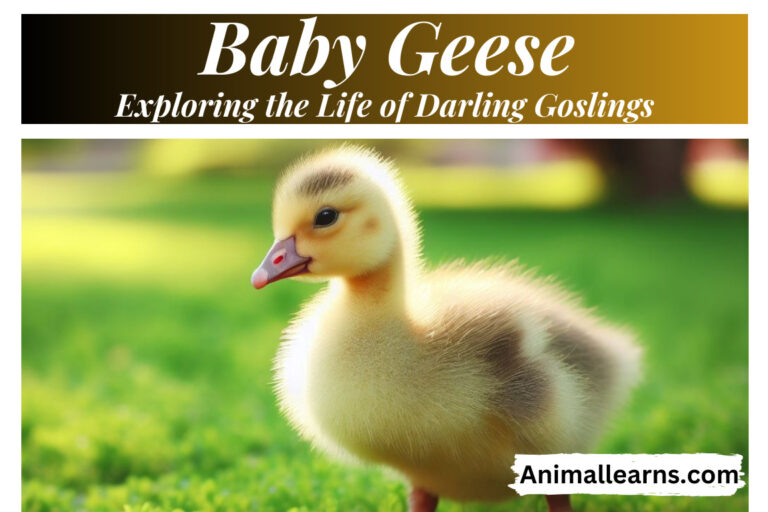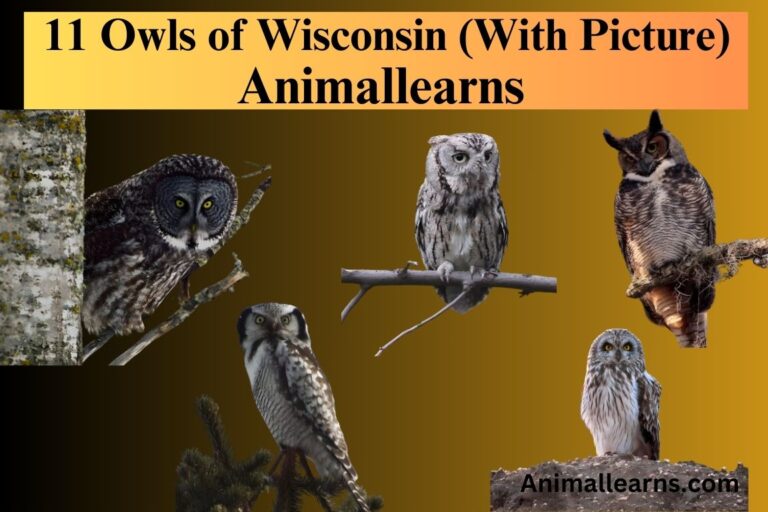Owls in Indiana | 8 Species of Owls (With Facts & Pictures) – Animallearns
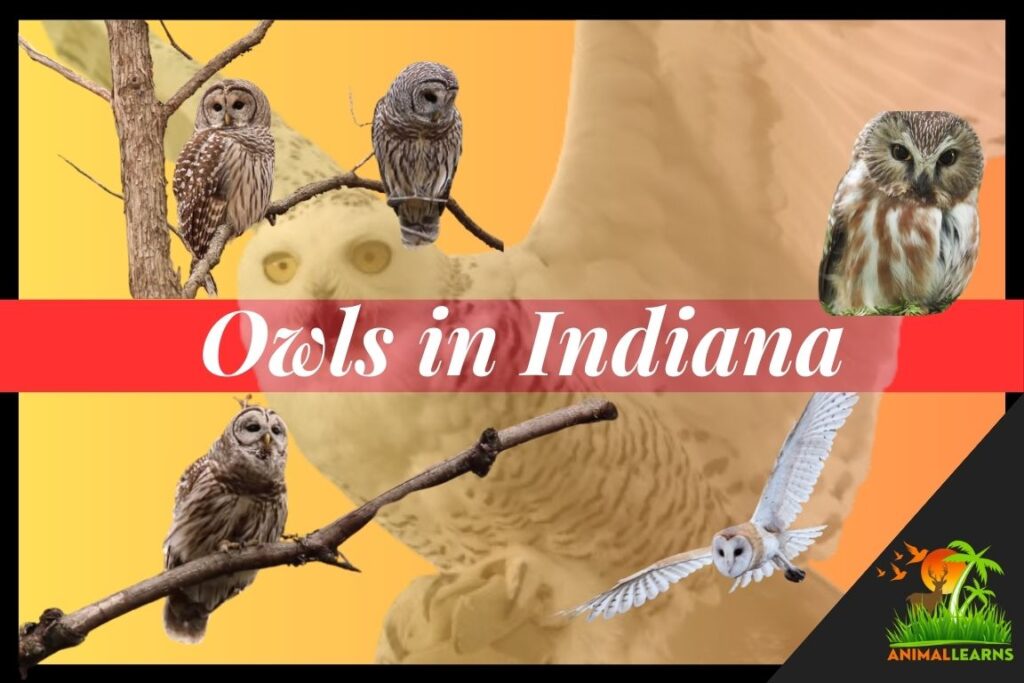
Indiana, bordering the Great Lakes, hosts a diverse wildlife population, including owls and other raptors, making ‘owls in Indiana‘ a prominent wildlife topic.
This essay sets out to discover the mysteries of these nocturnal predators who make Indiana home, from the stately Great Horned Owl to the secretive Eastern Screech Owl. Prepare to enter into the realm of quiet flight, sharp senses, and extraordinary adaptations, as we unravel the fascination of Indiana’s owl population.
This article will discuss the 8 different species of owls found in Indiana, as well as where and how to look for them.
8 Species of Owls in Indiana
Contents
- 1 8 Species of Owls in Indiana
- 1.1 Great Horned Owl
- 1.2 Great Horned Owl Facts
- 1.3 American Barn Owl
- 1.4 American Barn Owl Facts
- 1.5 Barred Owl
- 1.6 Barred Owl Facts
- 1.7 Eastern Screech-Owl
- 1.8 Eastern Screech-Owl Facts
- 1.9 Long-eared Owl
- 1.10 Long-eared Owl Facts
- 1.11 Short-eared Owl
- 1.12 Short-eared Owl Facts
- 1.13 Northern Saw-whet Owl
- 1.14 Northern Saw-whet Owl Facts
- 1.15 Snowy Owl
- 1.16 Snowy Owl Facts
- 2 Where to find Owls in Indiana
- 3 Conclusion
- 4 FAQs
Great Horned Owl

- Scientific name: Bubo virginianus
- Life span: 25 – 50 years
- Size: 43 to 64 cm (17 to 25 in)
- Weight: 1200 to 1600 g (2.64 to 3.52 lbs)
- Wingspan: 91 to 153 cm (3ft 0in to 5ft 0in)
It is common to see Great Horned Owls in Indiana. These raptors are really found practically everywhere in North America, from the tropics to the Arctic. As long as trees and rocky nesting places are there, its habitat is almost limitless. A greater adaptability than that of a Great Horned Owl is difficult to come by.
These owls are enormous and have a ferocious appearance! To recognize them, search for the large feathered tufts on their head that mimic ears. And take a look at those menacing eyes. I’m sure I wouldn’t want to engage in a staring match with one of them!
Males and females both hoot, although the male voice is lower pitched. At night, males may be heard calling from many kilometers away, marking their territory. The Great Horned Owl is, in my opinion, the best species of owl for hooting!
To maintain their larger proportions, these owls typically consume larger prey. They hunt for rodents, several bird species, groundhogs, geese, rabbits, and even other raptors! However, these owls also have little trouble consuming tiny prey, including rodents, scorpions, crustaceans, frogs, and insects.
It’s interesting to note that Great Horned Owls hunt and consume skunks due to their poor sense of smell!
Great Horned Owl Facts
- Great Horned Owls can rotate their heads almost 270 degrees from the front due to their long necks.
- Their large eyes help them see in the dark, but they cannot move them in their sockets like humans.
- The ear tufts of Great Horned Owls are not their ears; their actual ears are hidden under facial disk feathers.
- After eight years of birding, the person saw their first owl, specifically a Great Horned Owl.
American Barn Owl
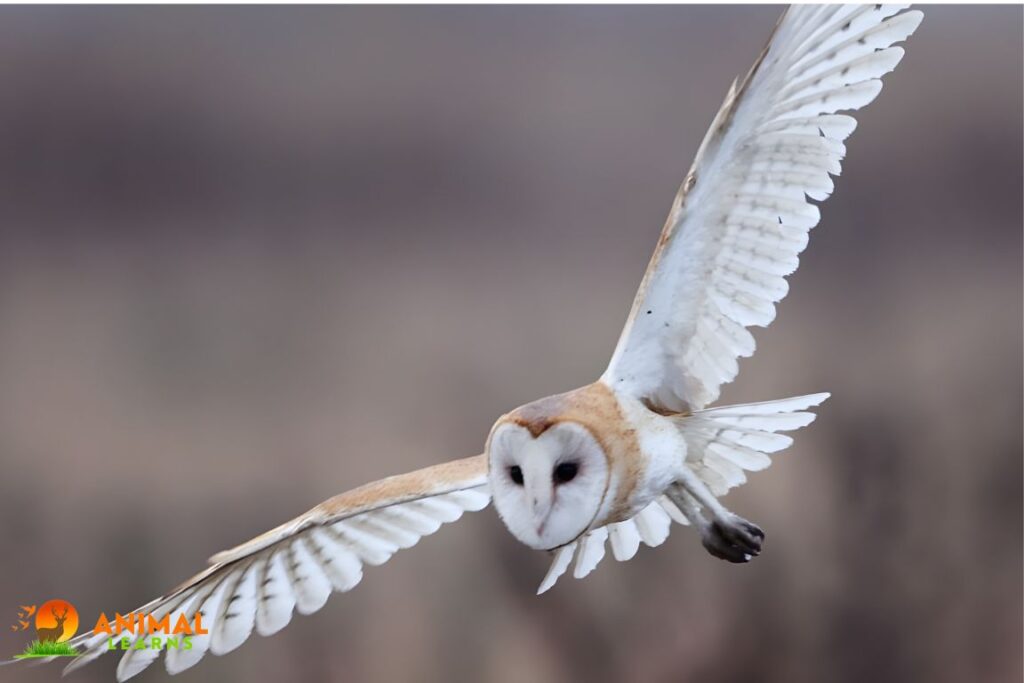
- Scientific name: Tyto furcata
- Life span: 10 years
- Size: 34 to 38 cm (13 to 15 in)
- Weight: 400 to 600 g (0.88 to 1.3 lbs)
- Wingspan: 29 to 36 cm (11 to 14 in)
The face of a barn owl, also known as a church owl, ghost owl, or monkey-faced owl, is heart-shaped and has a dark brown border. An interesting fact about owls is that their faces direct sound into their ears, making them the most effective hunters by sound that have ever been studied.
They can easily find tiny creatures beneath thick snow or brush thanks to their excellent hearing, and they even go bat hunting!
Barn Owls come in almost forty distinct types. The biggest variety is the American (Tyto furcata), weighing 555 grams (1 pound, 4 ounces), while the smallest species is found in the Galapagos Islands, with 260 grams (9.2 ounces).
Non-migratory barn owls can be found all year round in Indiana. The term comes from the fact that these nocturnal animals often live in abandoned barns. In many regions of their range, they are extremely endangered.
Farmers still like them, though, since they keep the surrounding land relatively free of rodents and shield other animals from the illnesses that mice and rats may spread. They don’t “hoot” in the manner that other owls do.
American Barn Owl Facts
- Barn owls molt their feathers periodically, replacing them with new ones.
- Barn owls mate for life, maintaining one partner throughout their lives.
- In England, seeing a barn owl was believed to be a harbinger of impending death, leading to superstitions.
- Barn owls have asymmetrical ears, with one positioned higher than the other.
- Barn owls screech instead of hooting, producing an extremely loud and ear-shattering sound.
Barred Owl

- Scientific name: Strix varia
- Life span: 8 years
- Size: 40 to 63 cm (15 to 25 in)
- Weight: 610 to 1,150 g (1.34 to 2.54 lb)
- Wingspan: 96 to 125 cm (38 to 49 in)
In comparison to other owl species, Barred Owls have incredibly tiny territories and do not migrate. Not a single owl that was banded and later located in a survey of 158 of them had traveled more than six kilometers.
The Barred Owl is widespread over the majority of the eastern states and southern Canada, despite its narrow range and lack of spirit of adventure. The whole body of the Barred Owl is brownish-grey, with black stripes running down its underside.
When building their nests, barred owls often use tree cavities in mature woods. They could also make use of abandoned crow or hawk nests. Frequently, monogamous breeding pairs stick to the same nest location year after year.
The female usually lays two to four eggs during the nesting season, which usually starts in late winter or early spring. During this period, the male helps feed the female.
As opportunistic hunters, barred owls target a range of small animals, including squirrels, voles, and mice. They also consume fish from time to time, along with birds, amphibians, and reptiles.
They hunt by softly perching and then swiftly diving to get their prey. Their ability to modify their food helps them survive in a variety of environments.
Although they are not endangered worldwide, some regions have seen a decline in barred owl populations due to habitat loss and fragmentation. The logging industry and urbanization are two examples of how human activity has destroyed their ideal environments.
Barred Owl Facts
- Barred owls have a distinctive hooting call that can startle individuals who are unfamiliar with it.
- These birds can be large in size, occasionally surprising unsuspecting people when spotted in wooded areas.
- The order of hatching determines the size of barred owl chicks, with the first egg hatched producing the largest chick, followed by progressively smaller ones.
- Barred owl chicks remain in the nest longer than chicks of other owl species.
- They possess strong bills and talons, enabling them to climb trees adeptly.
Eastern Screech-Owl
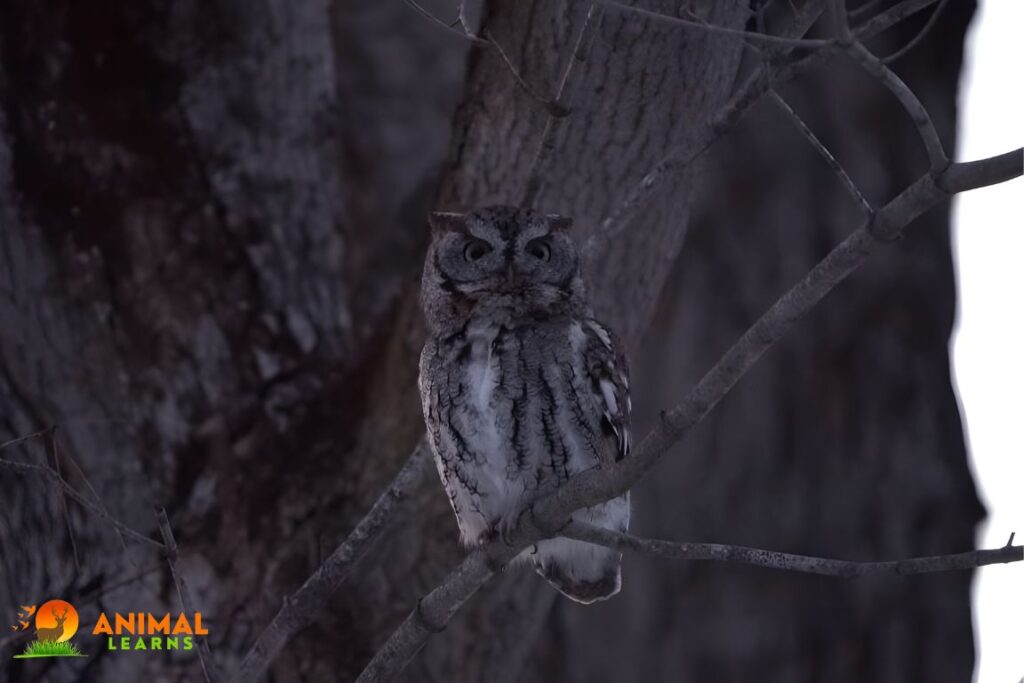
- Scientific name: Megascops asio
- Life span: 8 to 10 years
- Size: 16 to 25 cm (6.5 to 10 in)
- Weight: 121 to 244 g (4.25 to 8.5 oz)
- Wingspan: 46 to 61 cm (18 to 24 in)
Eastern Screech-owls are small, stocky, and neckless, which can make you think of professional wrestlers! These owls are either red or grey, with around one-third of the population being red.
On top of their skull, Eastern Screech-owls have “fake” ear tufts. Naturally, these are fake since owls really have real ears that are located on the sides of their heads, parallel to their eye line, beneath their feathers.
The tufts may be manipulated to communicate with other owls, such as to tell a partner, “This is a safe spot,” or to tell a rival, “Back off!” The tufts can also be used as simple camouflage to break up their profile.
“owls in Indiana,” will nest in practically any forested location. Larger owl populations, such as those of the Great Horned Owl, are avoided by screech-owls. They are at ease making their nests within crowded buildings, on top of streetlamps, and adjacent to busy roads and highways, suggesting that they don’t mind people too much.
Eastern Screech-Owl Facts
- Screech owls are the smallest owls in North America.
- They employ impressive predator evasion techniques, including camouflage and body manipulation.
- Screech owls have acute hearing, enabling them to locate prey under heavy vegetation or snow.
- In Greek mythology, owls were considered protectors and symbols of victory.
- Eastern screech owls are known for their mellow calls rather than screeches.
Long-eared Owl

- Scientific name: Asio otus
- Life span: 10 to 27 years
- Size: 31 to 40 cm (12 to 16 in)
- Weight: 160 to 435 g (5.6 to 15.3 oz)
- Wingspan: 86 to 102 cm (2ft 10in to 3ft 4in)
Usually nesting in woods or deep forests, long-eared owls like trees with lots of foliage for hiding places. They are dependent on naturally occurring tree cavities or abandoned hawk or crow nests. Monogamous behavior is displayed by breeding pairs, when both parents help with egg incubation and childrearing.
Parents employ their amazing ability to blend in with their surroundings to shield their young from any predators, and nests are closely guarded.
The main food source for the Long-eared Owl is small animals, especially rodents like mice, voles, and shrews. They are expert nocturnal predators who glide stealthily through the shadows to surprise their victim.
Their keen sense of hearing and eyesight help them locate and catch their prey with accuracy.
They exhibit some degree of nutritional flexibility when they add birds, insects, and amphibians to their diet.
The Long-eared Owl is not in worldwide danger, although it does encounter difficulties because of habitat deterioration and loss. For mature forests and woodland regions to survive, protection is essential.
There are initiatives in place to encourage ethical land management, save nesting locations, and increase public understanding of the significance of maintaining the ecosystems that sustain these amazing birds. Gaining a better understanding of their conservation requirements is facilitated by researching their behavior and population monitoring.
Long-eared Owl Facts
- Long-eared owls are known for their distinctive long ear tufts, which are actually feathers that enhance their camouflage.
- They possess exceptional hearing that aids them in locating prey with precision, even in complete darkness.
- They display agile and silent flight, aiding in surprising prey without detection.
Short-eared Owl

- Scientific name: Asio flammeus
- Life span: 12 years
- Size: 34 to 43 cm (13 to 17 in)
- Weight: 206 to 475 g (7.3 to 16.8 oz)
- Wingspan: 85 to 110 cm (33 to 43 in)
This medium-sized, mottled owl with tawny-brown markings is found all throughout North America. These birds hunt mostly during the day when their preferred prey, voles, are in motion. It’s interesting to note that they are among the most often sighted owls in the daytime!
Typically, short-eared owls inhabit open areas. In Indiana, the greatest times to see them are at dawn or dusk in meadows, fields, grasslands, and even airports.
In wide spaces, these owls construct their nests on the ground. The parent will excrete on the eggs to deter predators if it must leave the nest to avoid being eaten. Like a Kildeer, a Short-eared Owl will appear to be crippled and hop away to entice predators away from its nest.
Voices from Short-eared Owls are not very loud. However, these birds have a strange cry that surprisingly sounds a lot like a cat courting a partner when they do make noise.
Short-eared Owl Facts
- Short-eared owls are one of the most widespread owl species globally, found on five continents.
- They have black rings around their eyes, resembling mascara.
- Short-eared owls use their long, broad wings to soar like hawks during migration.
- They are active both day and night during the nesting season but primarily nocturnal otherwise.
- Short-eared owls nest on the ground, making them vulnerable to mammalian predators, though both parents defend the nest.
Northern Saw-whet Owl

- Scientific name: Aegolius acadicus
- Life span: 7 to 17 years
- Size: 17 to 22 cm (6.7 to 8.7 in)
- Weight: 54 to 151 g (1.9 to 5.3 oz)
- Wingspan: 42 to 56.3 cm (16.5 to 22.2 in)
Saw-whet in the North The owl is a tiny animal with a broad, rounded head. They feature light brown vertical stripes, a white underbelly, and a brown back and head with white dots. They have piercing golden eyes and a white disk on their face.
Saw-whet in the North Owls may be found all year round in several regions of North America, such as Southern Canada, the Northeastern, Northwestern, and Midwestern states of the United States, as well as some regions of Mexico.
They eventually fill up the remaining areas of the United States throughout the winter, sometimes traveling as far south as Texas and Louisiana, where they don’t spend the remainder of the year.
Saw-whet in the North Owls consume tiny prey, including mice. They also consume tiny birds and other small animals. From deciduous to coniferous woodlands are home to Northern Saw-whet Owls. Since they don’t always occupy the same roost, they are infamously hard to locate.
Look for white-washed branches and pine stands (this bird seems to enjoy roosting in conifers) if you want to try to find one. Finding Saw-whet Owls can also be accomplished by listening for their call, which is a prolonged “toot toot” that is repeated repeatedly between late winter and early spring.
Northern Saw-whet Owl Facts
- Saw-whet owls are one of the smallest owl species in North America.
- They inhabit dense thickets, typically at high levels, but can also be found up to 20 feet high.
- Saw-whet owls are at risk of predation by larger owls and raptors.
- Northern Saw-whet Owls are migratory birds with no strict migration pattern.
Snowy Owl

- Scientific name: Bubo scandiacus
- Life span: 10 to 28
- Size: 52.5 to 64 cm (20.7 to 25.2 in)
- Weight: 1706 to 2426 g (3.76 to 5.34 lb)
- Wingspan: 146 to 183 cm (4ft 9in to 6ft 0in)
During the winter, the very identifiable Snowy Owl, an Arctic owl, migrates to North America. Its plumage is mostly white, with males having whiter feathers than females. In contrast to other owl species, Snowy Owls are able to stay active day and night in order to adjust to the long summer days and short winter days in the Arctic.
They are migratory birds that travel great distances every year to and from their breeding and wintering habitats. In the Arctic tundra, snowy owls construct their nests on the ground using hollows that have been scraped out and lined with grass and feathers.
The female in a monogamous breeding pair produces a clutch of three to eleven eggs. The newborn owlets can leave the nest in a few weeks, and both parents help with incubation and care.
Lemmings are a tiny rodent species that are common in the Snowy Owl’s Arctic environment and make up the majority of their diet. They adjust their diet to include various small animals, birds, and even fish during years with low lemming populations. They hunt by perching or flying, using their excellent vision to find prey and then swooping down to get it.
At the moment, snowy owls are not thought to be endangered worldwide. They do, however, confront certain difficulties, including as disruptions to their mating grounds and effects of climate change on their Arctic environment.
The main goals of conservation initiatives include population monitoring, ecological research, and safeguarding important nesting locations. Campaigns to raise awareness encourage considerate behavior from people in order to reduce disruptions to Snowy Owls.
Snowy Owl Facts
- Snowy owls use their sensitive beaks, covered with facial feathers, to sense objects.
- Unlike most owls, snowy owls hunt during daylight.
- Their wingspan averages four to five feet, aiding them in silent movement and prey stalking.
- Female snowy owls have dark bars on their plumage, unlike males.
- Snowy owls swallow their food whole without chewing.
Where to find Owls in Indiana
For owl fans, Indiana provides excellent chances to see these amazing birds in their native environments. Go to places like woods, woodlands, and wetlands that are good owl habitats if you want to see owls in Indiana.
The Hoosier National Forest, Prophetstown State Park, Brown County State Park, and Patoka River National Wildlife Refuge are the four places that are suggested for exploration. Visit these spots in the early morning or late evening when owls are most active to improve your chances of seeing them.
Keep an ear out for owl cries, search tree branches thoroughly, and look for roosting locations. To protect the owls, keep in mind to respect their area and watch from a distance.
Conclusion
Finally, owl aficionados may find and enjoy a variety of habitats throughout Indiana that are ideal for learning about and appreciating these magnificent birds. Observers may fully immerse themselves in the captivating world of Indiana’s owls and get a greater knowledge and appreciation for these amazing creatures by visiting these places during prime periods and giving the owls room.
FAQs
What is the most common owl in Indiana?
With the exception of Antarctica, every continent is home to the barn owl, which has the greatest distribution of any owl species. Southern Indiana is home to a greater number of barn owls, who are ill-suited for the cold. Despite their infrequent presence in northern Indiana, the majority of known nests of barn owls have been found in the southern portion of the state.
What do owls in Indiana eat?
Because they are carnivores, owls exclusively consume meat. Although barred owls prefer to eat mice, they will also consume spiders, songbirds, amphibians, and even smaller owls.
How do you attract owls in Indiana?
Constructing an owl nesting box is a highly effective method, and it’s surprisingly simple to execute. Nesting boxes are artificial buildings that assist offer owls a place to roost and protection from other animals. Many owl species in Indiana would greatly benefit from these structures.
What bird screeches at night in Indiana?
Eastern Screech Owl, Barred Owl, Great Horned Owl (all common).
Are owls rare in Indiana?
One of the most fascinating natural species in Indiana is the owl. From the early Greek tales to the Harry Potter series, they have been honored in literature. Despite being widespread across the state, owls remain comparatively obscure, most likely due to their nocturnal lifestyle.
What bird is Indiana known for?
We thus approve and recognize Richmondena Cardinalis Cardinalis, often known as the Red Bird or Cardinal, as the official state bird of the state of Indiana.









